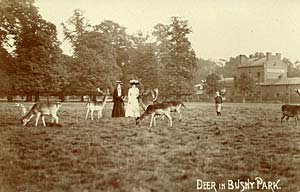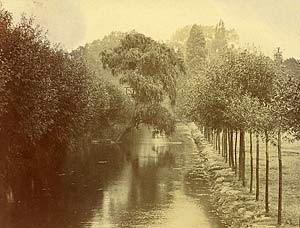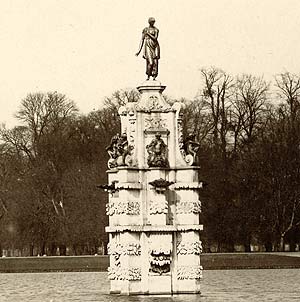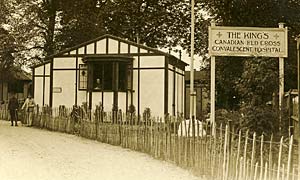BUSHY PARK
The vast expanse of Bushy Park (1,099 acres) makes it the second largest Royal park in London. Lying to the north of Hampton Court Palace, the history of Bushy Park is inextricably linked to the Palace. Most people in Hampton live within walking or cycling distance of the park and will quickly volunteer how much they enjoy the park for its wide open spaces, for a sight of the 325 deer which roam in the grounds or for the beautiful, 60-acre Waterhouse Woodland Gardens. There is a lot more to Bushy Park than can be explained in this brief summary. However, it is hoped that what you read here will whet your appetite to discover more for yourself.
When Henry V111 was “given” Hampton Court Palace by Cardinal Wolsey, he began to adapt the buildings and the parks straightaway. The Home Park and Bushy Park formed King Henry’s deer park at Hampton Court Palace. In the reign of James 1, a further 168 acres were taken into the park on the Hampton side. An avenue of lime trees planted in 1622 became the Chestnut Avenue later in the century.
This waterway, known as the Longford River, adds much to the beauty of the lower levels of the park. One branch of the canal flows from the Arethusa Fountain (usually known as the Diana fountain) in the centre of the circular pond close to the Hampton Court Gate, through a culvert underneath the road to the canal in Hampton Court Gardens and the Long Water in Hampton Court Park before joining the Thames. Another branch of the canal, the Queen’s River, tumbles over a waterfall at the entrance to the southern Waterhouse Woodland Gardens to supply the Arethusa fountain.
The Waterhouse Woodland Gardens, originally a woodland walk created in 1925, consists of two early nineteenth century plantations. They are an enclosed area within Bushy Park where dogs and cyclists are not allowed. They are at their best in the Spring when first the snowdrops, daffodils and camellias appear, followed by the massive plantings of rhododendrons, azaleas and bluebells in full flower. Dating back to King Henry VIIIth’s day, when Bushy Park was enclosed so that it could be used as a hunting area, some 125 Red deer and 200 Fallow deer roam the park, adding interest for visitors to the park and a sense of continuity with the history of the park.
A major restoration project is underway in Bushy Park. One of the first priorities are the Water Gardens, created by the Earl of Halifax in 1709-1710 when he became Ranger of Bushy Park. In their day, the Water Gardens were magnificent and famous with grottoes, a cascade between two pools and water flowing to two further pools, one in front of Upper Lodge. Only the two main pools, altered in shape, overgrown by plants and shrubbery and concealed from public view, will be restored. In times past, the Upper Lodge Water Gardens were positioned to provide a perfect view across the park and meadow to the Brewhouse. The first stage has been to fell the diseased Chestnut trees which have grown up like Topsy around the two pools. Restoration work is expected to be completed in 2008. The restoration of this important eighteenth century landmark will bring back the Water Gardens into the public domain for the first time in many decades. They may well be regarded as the jewel in the crown in Bushy Park. As well as the Water Gardens, the Heritage Lottery Fund is supporting the restoration or development of the Woodland Gardens, the Arethusa fountain, the eighteenth century Brewhouse, a new Welcome Centre, the Stockyard Education Centre and the Head Gardener, community and education workers In the south west corner of the park, the old farm site known as The Stockyard, has an Education Centre for use by schools. Close by is an indoor riding school used by Riding for the Disabled. Further information on Bushy Park can be obtained from the White Lodge, The Stockyard, Bushy Park, Hampton Court Road, Hampton, Middlesex, TW12 2EJ (telephone 020 8979 1586) or through the website www.royalparks.gov.uk.
|

 The flat site of Bushy Park lies within a loop of the Thames which has been settled for 4,000 years. A Bronze Age barrow was excavated in the park and there is evidence of an early farming community and traces of the largest and most complete mediaeval field system in Middlesex. Before it became a park, the area to the west belonged to the village of Hampton and was called Eastfield because it was cultivated land east of the village. In 1514, when Hampton Court Palace was being built for Cardinal Wolsey, an additional 400 acres was acquired and fenced. In all, Cardinal Wolsey had three separate parks enclosed from ploughed farmland: Bushy Park, Middle Park and Hare Warren. This was all in addition to the Home Park of Hampton Court Palace.
The flat site of Bushy Park lies within a loop of the Thames which has been settled for 4,000 years. A Bronze Age barrow was excavated in the park and there is evidence of an early farming community and traces of the largest and most complete mediaeval field system in Middlesex. Before it became a park, the area to the west belonged to the village of Hampton and was called Eastfield because it was cultivated land east of the village. In 1514, when Hampton Court Palace was being built for Cardinal Wolsey, an additional 400 acres was acquired and fenced. In all, Cardinal Wolsey had three separate parks enclosed from ploughed farmland: Bushy Park, Middle Park and Hare Warren. This was all in addition to the Home Park of Hampton Court Palace. The ornamental waterworks in Bushy Park and at Hampton Court Palace were initiated by Charles1. He wanted to show how powerful he was by building fountains, lakes and ponds to rival those belonging to other European monarchs. However, to achieve his plan he needed a flow of water to work the fountains and fill the lakes. Water from the River Colne was directed to Hampton Court and the park. A canal, more than 12 miles long, was dug by hand and was completed in 9 months at a cost of £4,000.
The ornamental waterworks in Bushy Park and at Hampton Court Palace were initiated by Charles1. He wanted to show how powerful he was by building fountains, lakes and ponds to rival those belonging to other European monarchs. However, to achieve his plan he needed a flow of water to work the fountains and fill the lakes. Water from the River Colne was directed to Hampton Court and the park. A canal, more than 12 miles long, was dug by hand and was completed in 9 months at a cost of £4,000.  Sir Christopher Wren designed the setting for the Arethusa fountain and expanded the plans for Chestnut Avenue. The road down the centre of Chestnut Avenue was made in 1699 when additional lime avenues and the two inner rows of horse chestnuts (1,767 trees in all) were planted but it was not until 1713 that the Arethusa fountain was placed in its present position. From the early years of Queen Victoria’s reign, the Chestnut Sunday celebrations were held every Spring on the nearest Sunday to May 11th, when the horse chestnuts were in blossom and at their best. The celebrations ceased during World War 11 and were not resumed until 1976 but once again are a popular, annual celebration.
Sir Christopher Wren designed the setting for the Arethusa fountain and expanded the plans for Chestnut Avenue. The road down the centre of Chestnut Avenue was made in 1699 when additional lime avenues and the two inner rows of horse chestnuts (1,767 trees in all) were planted but it was not until 1713 that the Arethusa fountain was placed in its present position. From the early years of Queen Victoria’s reign, the Chestnut Sunday celebrations were held every Spring on the nearest Sunday to May 11th, when the horse chestnuts were in blossom and at their best. The celebrations ceased during World War 11 and were not resumed until 1976 but once again are a popular, annual celebration.  During World War 1 large numbers of Canadian troops were stationed in the park. One of the large houses in the park, Upper Lodge, (previously a hunting lodge rebuilt around 1710 by the first Earl of Halifax) was used as the King’s Canadian Hospital. In World War 11, part of Bushy Park became the site of a large US base called Camp Griffiss. In February and March 1944, General Eisenhower moved SHAEF (Supreme Headquarters Allied Expeditionary Forces) to Bushy Park from where the initial planning stages of Operation Overlord, the Normandy invasion, took place. Near the Teddington end of the park, not far from Chestnut Avenue, a USAAF Memorial Plaque commemorates these events. Only when the war was over did local people learn the vital role Bushy Park had played.
During World War 1 large numbers of Canadian troops were stationed in the park. One of the large houses in the park, Upper Lodge, (previously a hunting lodge rebuilt around 1710 by the first Earl of Halifax) was used as the King’s Canadian Hospital. In World War 11, part of Bushy Park became the site of a large US base called Camp Griffiss. In February and March 1944, General Eisenhower moved SHAEF (Supreme Headquarters Allied Expeditionary Forces) to Bushy Park from where the initial planning stages of Operation Overlord, the Normandy invasion, took place. Near the Teddington end of the park, not far from Chestnut Avenue, a USAAF Memorial Plaque commemorates these events. Only when the war was over did local people learn the vital role Bushy Park had played.